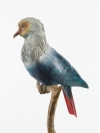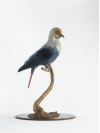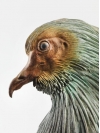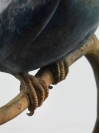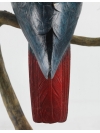
Mauritius Blue Pigeon
By Nick Bibby- Size:
- 28.5 × 41 × 28.5cm
- Medium:
- Bronze
- Edition size:
- 10
Alectroenas nitidissima
The spectacular ruff and crest of this species made it a most striking pigeon. The surviving Seychelles and Comoro species are less dramatic although they are closely related.
The species is known from preserved skins and bones, descriptions and illustrations. It was first noted in 1774 by P. Sonnerat who called it 'Pigeon Hollandais' because the three colours of its plumage, red, white and blue reminded him of the flag of Holland. One of the three remaining skins is a specimen collected by Sonnerat.
The pigeon was described as living a largely solitary existence along river courses in the forest, feeding on fruit and freshwater molluscs.
It is thought to have become extinct around the 1820's although the reasons for this are unclear. This striking bird would have made an easy target for the early colonists' guns but there may also have been direct competition from introduced species such as crab-eating Macaques.
